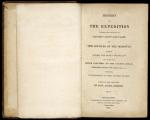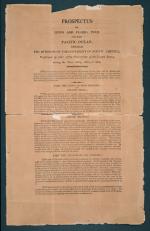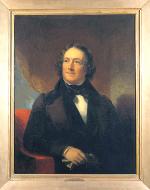![header=[Marker Text] body=[The financier, statesman, and scholar lived here. President, 1823-1836, Second Bank of the United States, the nation's central bank. He also spurred the rise of Greek Revival architecture and edited the journals of the Lewis and Clark Expedition.] sign](http://explorepahistory.com/kora/files/1/10/1-A-18A-139-ExplorePAHistory-a0a9b0-a_450.gif)
Mouse over for marker text
Name:
Nicholas Biddle (1786-1844)
Region:
Philadelphia and its Countryside/Lehigh Valley
County:
Philadelphia
Marker Location:
715 Spruce Street, Philadelphia
Behind the Marker
On March 23, 1814, Nicholas Biddle wrote these long-awaited words to William Clark: "I have at last the pleasure of informing you that the Travels are published…they have sold very well…and have been well thought of by readers."
Eight years after Lewis and Clark's return, the official account of their great voyage was finally released to the public. Called the History of the Expedition Under the Command of Captains Lewis and Clark to the Source of the Missouri, Thence Across the Rocky Mountains and Down the Columbia River to the Source of the Pacific Ocean, this landmark in American publishing contained an introduction by Thomas Jefferson, a narrative by Biddle based on Lewis and Clark's journals, and a detailed map of the geography of the western part of the North American continent.
Despite what Biddle wrote to Clark, however, the first edition of 2,000 copies did not sell well. More than 600 copies of the first edition of Biddle's history were incomplete, and the public's appetite for information about the Expedition had long since been satisfied by more timely narratives, including Patrick Gass's Journal of the Voyages and Travels of the Corps of Discovery, published seven years earlier. The official publication also failed to include the volume on the scientific and ethnographic discoveries that many, including Jefferson, had so eagerly anticipated.
Patrick Gass's Journal of the Voyages and Travels of the Corps of Discovery, published seven years earlier. The official publication also failed to include the volume on the scientific and ethnographic discoveries that many, including Jefferson, had so eagerly anticipated.
Upon his triumphant return to the East in the fall of 1806, Meriwether Lewis had promised Jefferson he would quickly publish a full account of the expedition. The next summer Philadelphia publisher John Conrad had issued a prospectus for a three-volume work that would include a narrative of the Expedition, and a study of the geography, the Indian tribes they had encountered, and the scientific findings of the amazing trip. After making arrangements for publication in Philadelphia, Lewis never did work on the book. And after his suicide in October, 1809, all of his journals might have been lost, had not an Indian trader in Nashville held onto two trunks that contained all of Lewis's papers until they were claimed.
Meriwether Lewis had promised Jefferson he would quickly publish a full account of the expedition. The next summer Philadelphia publisher John Conrad had issued a prospectus for a three-volume work that would include a narrative of the Expedition, and a study of the geography, the Indian tribes they had encountered, and the scientific findings of the amazing trip. After making arrangements for publication in Philadelphia, Lewis never did work on the book. And after his suicide in October, 1809, all of his journals might have been lost, had not an Indian trader in Nashville held onto two trunks that contained all of Lewis's papers until they were claimed.
Upon Lewis' death, publication of the official history fell to William Clark, who traveled to Philadelphia in January, 1810 to revive the project. There, influential friends - including Charles Willson Peale, who painted his portrait - encouraged Clark to edit the journals himself, but Clark insisted on someone with more time and more experience. To find that person, Clark met with publisher John Conrad, botanist Bernard McMahon, and three of Lewis" original mentors: Benjamin Rush,
Benjamin Rush,  Caspar Wistar, and
Caspar Wistar, and  Benjamin Smith Barton. Who could do this project justice?
Benjamin Smith Barton. Who could do this project justice?
Nicholas Biddle, by all accounts, was the one. A child prodigy, Biddle had entered the University of Pennsylvania at the age of ten and earned a degree from Princeton when he was just thirteen. While Lewis and Clark explored the West, Biddle had traveled to Europe to serve as secretary to American ambassadors John Armstrong in France and James Monroe in England. Back in Philadelphia in July 1807, Biddle completed his law studies, opened a legal practice, and was editing a new, national magazine called The Portfolio when Clark came calling.
When Clark first asked him to edit the journals, Biddle turned him down. But when Barton assured Biddle that he would edit the complex story of the Expedition's scientific discoveries, a tremendous portion of the text, he relented. In March 1810, Biddle accepted the assignment, assuring Clark that he would "do all that is in my power for the advancement of the work."
That spring Biddle visited Clark at Fincastle, Virginia, where he studied the journals, mastered the basic story of how the Expedition traversed the continent, and peppered Clark with questions. "Every little matter," Biddle wrote, "is a subject that excites curiosity." Returning to Philadelphia, he spent the remainder of the spring and most of the summer working on the project. But without Lewis to answer questions, he found the challenges "exceedingly troublesome." Biddle found some of the answers he needed by consulting the manuscript accounts of expedition diarist John Ordway, and by interviewing George Shannon, another veteran of the Expedition.
Working long hours for weeks on end, Biddle trimmed away two-thirds of the Lewis and Clark journals. In the process, he fashioned an epic adventure that reflected the culture and nationalism of America at the dawn of the 19th century. To fashion Lewis and Clark into heroes for the ages, Biddle downplayed Lewis's self-doubts and mood swings, made no mention of the six courts-martial or anything else that might have led readers to question Lewis and Clark's leadership and control, and stripped the expedition's members of their cultural diversity to create a story of "American" heroes. He omitted Lewis and Clark's extensive references to venereal disease and sexual relations with Native American women, downplayed the disputes and differences among members of the expedition, suppressed the personalities of the individual members, and cut Lewis's rich descriptions of landscapes and scenery.
By June 28, 1811, Biddle was "ready to put the work to press." A series of setbacks, however, including the failure of Conrad's publishing firm, put off publication until 1814. By then, Biddle had turned over editorial responsibilities to Paul Allen, a former colleague at The Portfolio.
The first edition of History of the Expedition Under the Command of Captains Lewis and Clark to the Source of the Missouri, Thence Across the Rocky Mountains and Down the Columbia River to the Source of the Pacific Ocean sold poorly. But in the decades that followed, Biddle's History would go through another twenty-two editions and remain the only legitimate recounting of the Lewis and Clark Expedition until 1893. In the early 20th century, publication of the full and original journals at last gave Americans a richer understanding of the diverse, complex, and often conflicted, Expedition. For the 19th century, however, Biddle's History provided the epic, patriotic, and authoritative account.
After completing his work on the history, Biddle enjoyed a long and controversial career. In 1818, President James Madison appointed Biddle one of the directors of the Bank of the United States. (That same year Biddle turned over the original Lewis and Clark journals to the American Philosophical Society in Pennsylvania, where they remain to this day.) As the Bank's president, Biddle helped navigate the nation's economy through a trying series of financial booms and busts, and engaged in a highly publicized power struggle with President Andrew Jackson that resulted in the withdrawal of the bank's charter in 1832.
In 1839, Biddle retired to Andalusia, his Greek Revival country estate that overlooked the Delaware River just north of Philadelphia. There he continued to receive prominent visitors from the nation and abroad until his death in 1844.
Eight years after Lewis and Clark's return, the official account of their great voyage was finally released to the public. Called the History of the Expedition Under the Command of Captains Lewis and Clark to the Source of the Missouri, Thence Across the Rocky Mountains and Down the Columbia River to the Source of the Pacific Ocean, this landmark in American publishing contained an introduction by Thomas Jefferson, a narrative by Biddle based on Lewis and Clark's journals, and a detailed map of the geography of the western part of the North American continent.
Despite what Biddle wrote to Clark, however, the first edition of 2,000 copies did not sell well. More than 600 copies of the first edition of Biddle's history were incomplete, and the public's appetite for information about the Expedition had long since been satisfied by more timely narratives, including
Upon his triumphant return to the East in the fall of 1806,
Upon Lewis' death, publication of the official history fell to William Clark, who traveled to Philadelphia in January, 1810 to revive the project. There, influential friends - including Charles Willson Peale, who painted his portrait - encouraged Clark to edit the journals himself, but Clark insisted on someone with more time and more experience. To find that person, Clark met with publisher John Conrad, botanist Bernard McMahon, and three of Lewis" original mentors:
Nicholas Biddle, by all accounts, was the one. A child prodigy, Biddle had entered the University of Pennsylvania at the age of ten and earned a degree from Princeton when he was just thirteen. While Lewis and Clark explored the West, Biddle had traveled to Europe to serve as secretary to American ambassadors John Armstrong in France and James Monroe in England. Back in Philadelphia in July 1807, Biddle completed his law studies, opened a legal practice, and was editing a new, national magazine called The Portfolio when Clark came calling.
When Clark first asked him to edit the journals, Biddle turned him down. But when Barton assured Biddle that he would edit the complex story of the Expedition's scientific discoveries, a tremendous portion of the text, he relented. In March 1810, Biddle accepted the assignment, assuring Clark that he would "do all that is in my power for the advancement of the work."
That spring Biddle visited Clark at Fincastle, Virginia, where he studied the journals, mastered the basic story of how the Expedition traversed the continent, and peppered Clark with questions. "Every little matter," Biddle wrote, "is a subject that excites curiosity." Returning to Philadelphia, he spent the remainder of the spring and most of the summer working on the project. But without Lewis to answer questions, he found the challenges "exceedingly troublesome." Biddle found some of the answers he needed by consulting the manuscript accounts of expedition diarist John Ordway, and by interviewing George Shannon, another veteran of the Expedition.
Working long hours for weeks on end, Biddle trimmed away two-thirds of the Lewis and Clark journals. In the process, he fashioned an epic adventure that reflected the culture and nationalism of America at the dawn of the 19th century. To fashion Lewis and Clark into heroes for the ages, Biddle downplayed Lewis's self-doubts and mood swings, made no mention of the six courts-martial or anything else that might have led readers to question Lewis and Clark's leadership and control, and stripped the expedition's members of their cultural diversity to create a story of "American" heroes. He omitted Lewis and Clark's extensive references to venereal disease and sexual relations with Native American women, downplayed the disputes and differences among members of the expedition, suppressed the personalities of the individual members, and cut Lewis's rich descriptions of landscapes and scenery.
By June 28, 1811, Biddle was "ready to put the work to press." A series of setbacks, however, including the failure of Conrad's publishing firm, put off publication until 1814. By then, Biddle had turned over editorial responsibilities to Paul Allen, a former colleague at The Portfolio.
The first edition of History of the Expedition Under the Command of Captains Lewis and Clark to the Source of the Missouri, Thence Across the Rocky Mountains and Down the Columbia River to the Source of the Pacific Ocean sold poorly. But in the decades that followed, Biddle's History would go through another twenty-two editions and remain the only legitimate recounting of the Lewis and Clark Expedition until 1893. In the early 20th century, publication of the full and original journals at last gave Americans a richer understanding of the diverse, complex, and often conflicted, Expedition. For the 19th century, however, Biddle's History provided the epic, patriotic, and authoritative account.
After completing his work on the history, Biddle enjoyed a long and controversial career. In 1818, President James Madison appointed Biddle one of the directors of the Bank of the United States. (That same year Biddle turned over the original Lewis and Clark journals to the American Philosophical Society in Pennsylvania, where they remain to this day.) As the Bank's president, Biddle helped navigate the nation's economy through a trying series of financial booms and busts, and engaged in a highly publicized power struggle with President Andrew Jackson that resulted in the withdrawal of the bank's charter in 1832.
In 1839, Biddle retired to Andalusia, his Greek Revival country estate that overlooked the Delaware River just north of Philadelphia. There he continued to receive prominent visitors from the nation and abroad until his death in 1844.
Beyond the Marker







